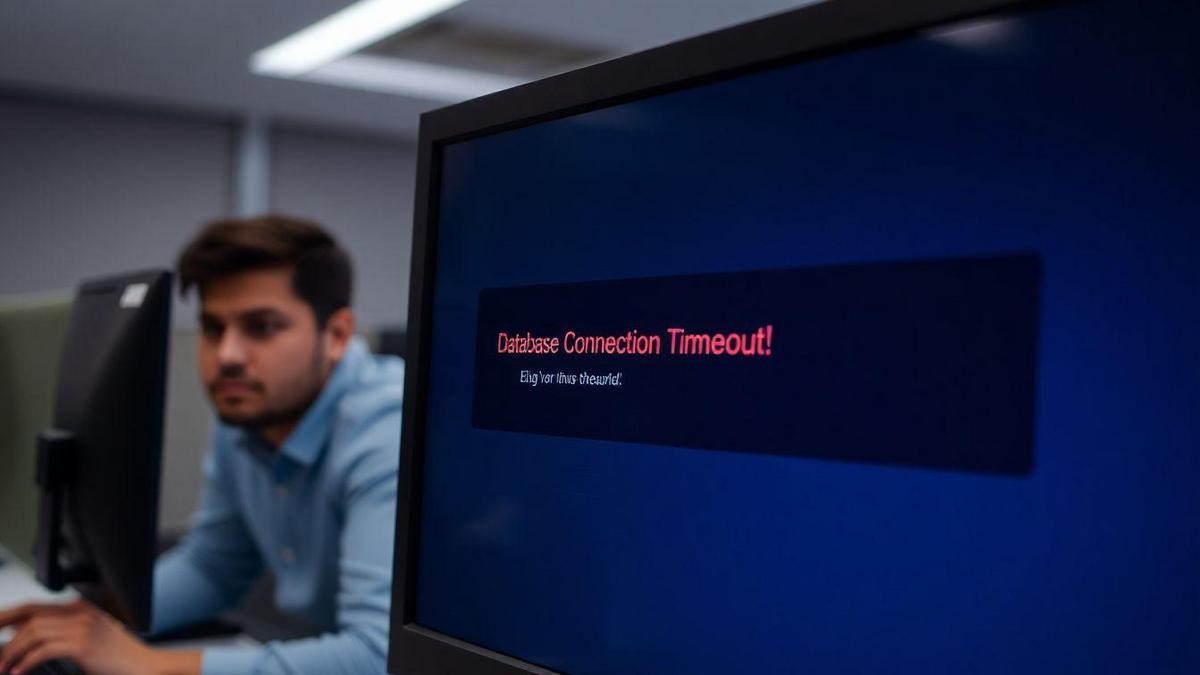Database Connection Error: Causes and Solutions is what we’re diving into today. If you’ve ever encountered a database connection error, you know how frustrating it can be. But don’t worry! We’ll break down everything from what these errors are, why they happen, and how you can fix them. Get ready to unlock some simple tips and tricks that’ll help you tackle those pesky connection issues like a pro. Let’s get started!

Understanding Database Connection Errors
What is a Database Connection Error?
When you try to connect to a database and it doesn’t work, that’s what we call a database connection error. It’s like trying to enter a locked door without the right key. You might see error messages popping up, and they can be frustrating. This error usually means that your application can’t communicate with the database for some reason.
Why Do You Experience Database Connection Errors?
There are a few common reasons why you might face these errors. Here are some of the culprits:
- Incorrect Credentials: If your username or password is wrong, the connection won’t happen.
- Server Issues: Sometimes, the database server might be down or busy.
- Network Problems: If your internet connection is shaky, you might lose the link to the database.
- Configuration Mistakes: If the settings in your application don’t match the database, you’re in trouble.
Common Signs of a Database Connection Error
You might notice these signs if you’re dealing with a database connection error:
| Signs of a Database Connection Error |
|---|
| Error messages on your screen |
| Slow loading times for your application |
| Inability to access certain features |
| Unexpected crashes or freezes |
If you see any of these signs, it’s time to dig deeper into what’s going wrong.
Common Causes of Database Connection Errors
When you’re trying to connect to your database, it can feel like you’re hitting a brick wall. Database connection errors can be frustrating, but understanding the common causes can help you troubleshoot and find solutions quickly. Let’s dive into a few typical culprits.
Network Issues Affecting Your Database
Sometimes, the problem isn’t with your database itself, but with the network. Think of your database as a house. If the road to your house is blocked, you can’t get there, right? Here are some network issues you might face:
- Firewalls: They can block the connection.
- Internet Outages: If your internet is down, so is your connection.
- Server Downtime: If the server hosting your database is offline, you won’t connect.
Incorrect Database Credentials
Another common issue is entering the wrong credentials. This is like trying to unlock a door with the wrong key. If you’re not careful, you’ll keep getting locked out. Here’s what you need to check:
- Username: Make sure it’s correct.
- Password: Double-check for typos.
- Database Name: Ensure you’re trying to access the right one.
How Authentication Failures Lead to Errors
Authentication failures happen when your credentials don’t match what the database expects. Picture this: you’ve got the right key, but you’re trying to use it on the wrong door. Here’s a quick overview of how this works:
| Issue | Description | Solution |
|---|---|---|
| Wrong Username | You’re typing the username incorrectly. | Double-check your username. |
| Wrong Password | A simple typo can cause this. | Try resetting your password. |
| Incorrect Database | Accessing the wrong database. | Verify the database name. |
Remember, even a small mistake can lead to a connection error. Stay sharp and double-check your inputs!

Database Connection Timeout Explained
What is a Database Connection Timeout?
A database connection timeout happens when your application tries to connect to a database but takes too long to do so. Think of it like waiting for a friend to pick you up, and they just don’t show up. After a while, you get tired of waiting and decide to leave. This timeout is a safety feature that prevents your application from hanging forever.
How to Identify a Timeout Issue
Identifying a timeout issue can be tricky. Here are some signs that might help you spot the problem:
- Error Messages: If you see messages like Connection Timed Out, that’s a clear sign.
- Slow Performance: If your app is running slower than molasses, it could be due to timeout issues.
- Logs and Alerts: Check your logs. They often tell you when connections fail.
Tips to Avoid Connection Timeouts
Here are some handy tips to help you dodge those pesky timeouts:
- Increase Timeout Settings: Sometimes, simply extending the timeout duration can solve the problem.
- Optimize Queries: If your database queries are taking too long, they might be the culprit. Streamline them to speed things up.
- Check Network Issues: Ensure your network is stable. A shaky connection can lead to timeouts.
- Use Connection Pooling: This keeps a set number of connections ready to use, speeding up access to the database.
| Tips to Avoid Timeouts | Description |
|---|---|
| Increase Timeout Settings | Extend the duration to allow more time for connections. |
| Optimize Queries | Streamline database queries to reduce execution time. |
| Check Network Issues | Ensure a stable network connection to prevent disruptions. |
| Use Connection Pooling | Maintain a pool of connections for quicker access. |
Troubleshooting Database Connection Issues
Steps to Diagnose Connection Problems
When you face a database connection error, it can feel like hitting a brick wall. But don’t worry! You can tackle this problem step by step. Here’s how you can diagnose connection issues:
- Check Your Credentials: Double-check your username and password. A simple typo can throw everything off.
- Verify the Database URL: Make sure the database URL is correct. Sometimes, it’s just a matter of a wrong character.
- Test Network Connectivity: Use the command line to ping the database server. If you can’t reach it, there’s a network issue.
- Look at Firewall Settings: Ensure that your firewall isn’t blocking the connection. You might need to adjust settings to allow access.
- Check Database Server Status: Is the database server up and running? Sometimes, it might be down for maintenance.
Tools to Help You Troubleshoot
Using the right tools can make troubleshooting a breeze. Here are some handy tools that can help you out:
| Tool Name | Purpose |
|---|---|
| Ping | Check network connectivity |
| Telnet | Test if a specific port is open |
| MySQL Workbench | Manage and troubleshoot MySQL databases |
| SQL Server Management Studio | Manage SQL Server databases |
Common Tools for Database Troubleshooting
Let’s dive deeper into some common tools that can assist you:
- Ping: A simple tool to see if your database server is reachable. Just type ping [server address] in your command line.
- Telnet: This helps check if the database port is open. Use telnet [server address] [port] to see if you can connect.
- Database Management Software: Tools like MySQL Workbench or SQL Server Management Studio can help you manage your databases and spot issues.
By using these steps and tools, you can get to the bottom of your database connection errors quickly.

Fixing Database Connection Errors
Quick Fixes for Common Errors
When you encounter a database connection error, it can feel like hitting a brick wall. But don’t worry! Here are some quick fixes you can try:
- Check Your Credentials: Ensure that your username and password are correct. A simple typo can cause a lot of headaches!
- Verify Database Server Status: Is the database server running? Sometimes it’s just a matter of the server being down for maintenance.
- Firewall Settings: Make sure your firewall isn’t blocking the database connection. You might need to adjust the settings.
- Connection Strings: Double-check your connection strings. They should match the database details exactly.
If you try these steps and still face issues, it might be time to take a deeper look.
When to Seek Professional Help
Sometimes, troubleshooting can feel like trying to find a needle in a haystack. If you’ve tried the quick fixes and nothing seems to work, it might be time to bring in the experts.
Signs You Need Expert Assistance
Here are some signs that indicate you might need professional help:
- Persistent Errors: If the same error keeps popping up, it’s a red flag.
- Complex Database Setup: If your database setup is intricate, a professional can help navigate it more effectively.
- Time Constraints: If you’re short on time and can’t afford to troubleshoot, calling in an expert can save you from frustration.
- Security Concerns: If you suspect a security issue, it’s best to consult with someone who knows the ins and outs.
Don’t hesitate to reach out for help. Sometimes, a fresh pair of eyes can spot what you might have missed!
Database Authentication Failures
Causes of Authentication Failures
When you encounter database authentication failures, it can feel like hitting a brick wall. These failures can stem from several issues, including:
- Incorrect Credentials: This is the most common culprit. If you’re typing the wrong username or password, the system won’t let you in.
- Expired Passwords: Sometimes, passwords have an expiration date. If yours has expired, you’ll need to update it.
- User Account Lockout: After several failed login attempts, your account might get locked for security reasons.
- Configuration Issues: Sometimes, the settings on the server side can be misconfigured, causing authentication problems.
How to Resolve Authentication Issues
Now that you know what might be causing those pesky authentication failures, let’s talk about how to fix them. Here are some straightforward steps you can take:
- Double-Check Your Credentials: Make sure you’re entering the right username and password. It sounds simple, but it’s often the easiest fix.
- Reset Your Password: If you suspect your password is expired or forgotten, use the password reset feature.
- Unlock Your Account: If your account is locked, follow your system’s procedure to unlock it. This usually involves waiting a bit or contacting support.
- Review Server Settings: If you have access, check the server settings to see if anything looks off. You may need help from your IT team.
Best Practices for Secure Authentication
To avoid these issues in the future, consider implementing some best practices for secure authentication:
- Use Strong Passwords: Create passwords that are hard to guess. Mix letters, numbers, and symbols.
- Enable Two-Factor Authentication: This adds an extra layer of security. Even if someone gets your password, they still need a second piece of information to access your account.
- Regularly Update Passwords: Change your passwords every few months to keep your accounts secure.
- Monitor Login Attempts: Keep an eye on your login attempts. If you see suspicious activity, take action immediately.
| Best Practices | Description |
|---|---|
| Strong Passwords | Use a mix of letters, numbers, and symbols. |
| Two-Factor Authentication | Adds an extra layer of security. |
| Regular Password Updates | Change passwords every few months. |
| Monitor Login Attempts | Watch for any suspicious activity. |

Resolving Database Connectivity Issues
Understanding Connectivity Problems
When you’re facing a Database Connection Error: Causes and Solutions, it can feel like hitting a brick wall. You may wonder why your application can’t communicate with the database. Common issues include:
- Incorrect Credentials: Sometimes, it’s just a typo in your username or password.
- Network Issues: Your server might be having trouble connecting to the database due to network problems.
- Database Server Down: If the database server is offline, there’s no way to connect.
- Firewall Restrictions: Firewalls can block the connection, preventing access to the database.
Solutions to Improve Connectivity
Now that you know what might be causing the problem, let’s look at some solutions. Here’s a handy table to help you remember:
| Problem | Solution |
|---|---|
| Incorrect Credentials | Double-check your username and password. |
| Network Issues | Test your connection with a ping command. |
| Database Server Down | Check the server status or contact your host. |
| Firewall Restrictions | Adjust firewall settings to allow database access. |
Making these adjustments can help you get back on track.
Long-Term Strategies for Better Connectivity
To keep your connection smooth in the long run, consider these strategies:
- Regular Maintenance: Check your database and server settings often.
- Monitoring Tools: Use tools to monitor your database connections in real-time.
- Backup Plans: Always have a backup in case of unexpected downtime.
By following these tips, you can avoid future connectivity headaches and keep your applications running smoothly.
Preventing Future Database Connection Errors
Regular Maintenance Tips
To keep your database running smoothly, you need to stay on top of regular maintenance. Think of it like tuning up your car; if you ignore it, you might end up stuck on the side of the road. Here are some simple tips to help you out:
- Update Software: Always keep your database software up to date. New updates often fix bugs and improve performance.
- Backup Regularly: Make sure to back up your database frequently. This way, if something goes wrong, you can restore it without losing important data.
- Optimize Your Database: Regularly check for any unnecessary data that can be cleaned up. This helps your database run faster and more efficiently.
Monitoring Your Database Connection
Monitoring your database connection is crucial. It’s like keeping an eye on the gauges in your car. You want to know if something is off before it becomes a big problem. Here’s how you can do it:
- Use Monitoring Tools: There are many tools available that can help you keep track of your database performance. They can alert you to any issues before they escalate.
- Check Connection Logs: Regularly review your connection logs to spot any unusual activity. This can help you catch problems early.
Setting Up Alerts for Connection Issues
Setting up alerts is like having a smoke detector in your house. You want to be warned before things get out of hand. Here’s how to set up alerts:
| Alert Type | Description |
|---|---|
| Email Alerts | Get notified via email when there’s a connection problem. |
| SMS Alerts | Receive text messages for immediate issues. |
| Dashboard Alerts | Use a dashboard to see real-time connection status. |
By implementing these strategies, you can minimize the chances of facing a Database Connection Error: Causes and Solutions. Keeping your database healthy means you can focus on what really matters—growing your business.

Learning from Database Connection Errors
Analyzing Past Errors for Improvement
When you hit a database connection error, it can feel like hitting a brick wall. But don’t let it get you down! Instead, take a moment to analyze what went wrong. Look back at the error messages you received. They can be like clues, guiding you to the root of the problem.
For example, if you see a message about timeout, it might mean your server is too slow or overwhelmed. On the other hand, if you encounter a credentials error, it could point to a typo in your username or password. By understanding these messages, you can avoid making the same mistakes in the future.
Building a Better Database Strategy
Now that you’ve learned from past errors, it’s time to build a better database strategy. Think of it as laying a strong foundation for a house. You wouldn’t want to build on shaky ground, right?
Here are some tips to consider:
- Regular Updates: Keep your database software up to date. Updates often fix bugs and improve performance.
- Backup Plans: Always have a backup of your database. If something goes wrong, you can restore it quickly.
- Monitoring Tools: Use tools to monitor your database. They can alert you to issues before they become big problems.
Creating a Database Error Log for Future Reference
Creating a database error log is like keeping a diary of your database’s health. Each time an error pops up, jot it down. This log will serve as a reference for you in the future.
Here’s how to set it up:
| Error Type | Date | Description | Solution |
|---|---|---|---|
| Connection Timeout | 2023-10-01 | Server took too long to respond | Increased timeout limit |
| Invalid Credentials | 2023-10-05 | Wrong username/password combination | Corrected login details |
By keeping track of these errors, you can spot patterns and make informed decisions to improve your database’s performance.
Frequently Asked Questions
What is a Database Connection Error?
A database connection error happens when your app can’t connect to the database. This can stop your app from working.
What causes a Database Connection Error?
There are many reasons! Your database might be down, wrong login details, or a network issue. Check each part.
How can I fix a Database Connection Error?
Start by checking your internet connection. Then, verify your login info. Restart your database server if needed.
Is it possible to prevent a Database Connection Error?
Yes! Keep your software updated and monitor your server’s health. Regular checks can help avoid issues.
Where can I find more information on Database Connection Error: Causes and Solutions?
You can visit tech forums, blogs, or the support page of your database provider. They have plenty of tips and guides!

Lucas is a technical SEO expert who has optimized over 200 websites and managed Google AdSense and Ad Manager campaigns since 2016. At ReviewWebmaster.com, he shares strategies to boost organic traffic and monetize every single visit.
Types of articles he writes:
-
“How to Increase Your Blog’s RPM with Simple Tweaks”
-
“Technical SEO Checklist for WordPress Sites”
-
“Complete Beginner’s Guide to Google Ad Manager”
Why it works:
Lucas brings a confident, analytical, and performance-driven voice to the site — perfect for readers looking for actionable, results-oriented content.
